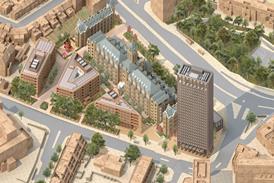The target for achieving net zero may still be decades away but, in order to hit it, we have to make changes to the way we design and build right now, says Anna Beckett

Hopefully by now we have all realised that there is a climate emergency. Global warming is accelerating at a pace the earth cannot sustain and the recently completed IPCC sixth assessment report stated that it is “now or never” for us to make changes that can really make a difference.
And, while the construction industry is starting to make changes that could help, we are not moving very quickly. Cost, programme and standard processes are all massive barriers to change. But does it really matter? What will actually happen if we don’t start making big changes?
Let’s imagine the situation between now and 2050 if the construction industry carries on exactly as it is now: there are some low-carbon projects and we understand the benefit of retrofit, but we have continued to use standard materials because it is easier.
Perhaps one of the first issues is likely to be a shortage of sand. Currently, sand is the second-most consumed material in the world after water and it is also a fundamental component in several structural materials, including both concrete and glass.
Carbon emissions aside, we cannot continue to use concrete the way we currently do – our environment simply cannot support it
But we are running out of it. In some countries this could be an issue as early as next year, but most estimates suggest that by 2050 it will be a significant problem.
To make concrete we need sand that has been shaped by water (rather than wind), but stripping beaches or dredging sand from the ocean floor causes extensive damage as well as accelerating erosion. Carbon emissions aside, we cannot continue to use concrete the way we currently do – our environment simply cannot support it.
What about other materials? The re-use of steel sections offers huge carbon savings but the systems and processes to do this are relatively new, and therefore it is both more effort and more expensive. Instead we are continuing to make new sections from recycled steel, which reduces the amount of virgin material required but still needs a huge amount of energy to produce them.
Production of iron and steel contributes to around 7% of global emissions so, if we continue at the same rate, it has a significant impact. But it is also worth considering that this energy requirement has already led to huge rises in the cost of steel as the cost of energy has risen.
If this continues, then it is possible at some point that the cost of new steel will exceed the cost of re-using steel sections. And, if that is the case, isn’t it better to start to get those processes in place now? By 2050 we will most likely have no option but to re-use steel.
One of the biggest contributors to global emissions is road transport and, while private car use makes up a large proportion of this, the transportation of construction materials, as well as site vehicles, also contributes.
Transportation is considered in carbon estimates but in many cases it is a general estimate – carbon savings during production may be cancelled out by the emissions produced during transportation without us even realising. This is only likely to get worse; as materials become more scarce, travel distances could increase considerably, adding to both emissions and costs.
The IPCC report described the next 30 months as the period in which significant changes needed to be made to reduce global emissions
And what will these buildings be like for their users? If we do not manage to reduce global emissions, then temperatures will continue to rise, flooding will increase and air pollution will worsen. This suggests that we might want more cooling in buildings, and we might want to do that in ways that don’t involve opening the windows.
Without the use of natural ventilation, we are adding significantly to the energy use of buildings, and unless we have designed them to generate their own power, then this is likely to be both expensive and add considerably to the whole-life carbon. So, while we are making the inside cooler, we are also making the outside hotter.
The question really is “when is now?” The IPCC report described the next 30 months as the period in which significant changes needed to be made to reduce global emissions. If we consider that the construction industry contributes to around 40% of global emissions, it is clear that we need to make big changes to the way we are working, and we need to do it quickly.
Thirty months takes us to 2025, but we are already designing the buildings that will be constructed in 2025. If we don’t start putting low-carbon design at the top of the agenda we will have missed our chance.
For the construction industry now really does mean now.
Postscript
Anna Beckett is an associate at Webb Yates Engineers
















No comments yet